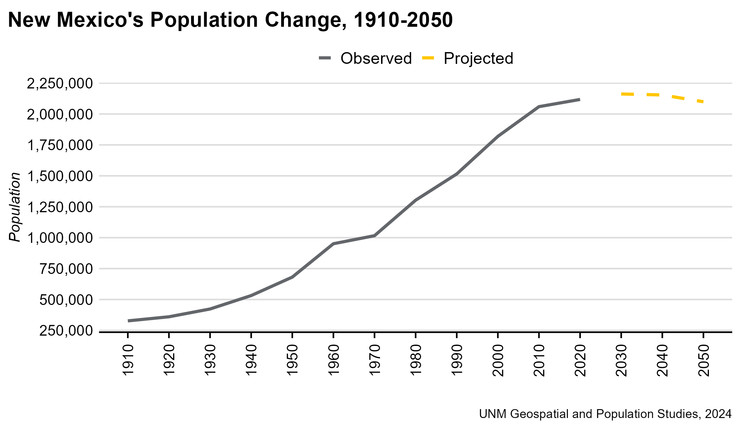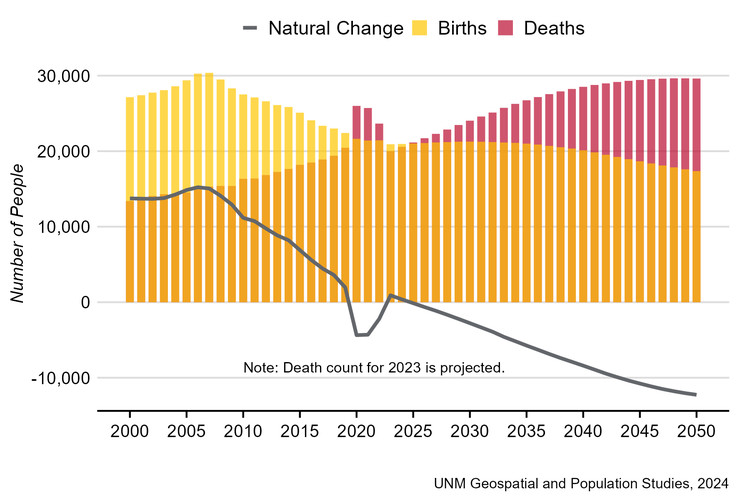New Mexico’s Flat Population Growth
Currently, New Mexico’s population stands at approximately 2.11 million residents. Projections indicate a slow growth phase until around 2035, peaking at 2.16 million. This modest increase of about 50,000 people, or 2.5% of the state’s population, suggests near-static overall growth. Following this peak, the population is expected to gradually decline through 2050 and beyond, indicating a long-term trend of population stagnation.
 New Mexico population trends from 1910 to 2050, showing projected flat growth and aging population.
New Mexico population trends from 1910 to 2050, showing projected flat growth and aging population.
Robert Rhatigan, Director of UNM-GPS and the New Mexico State Demographer, cautions that this projected growth is fragile. “We are projecting some growth for New Mexico in the coming years, but the increases are small enough that minor shifts in births, deaths, and especially migration trends could easily push growth up or result in years of decline,” Rhatigan explains. This highlights the delicate balance of factors influencing New Mexico’s population trajectory.
The Aging Demographic of New Mexico
A key demographic trend in New Mexico is its rapidly aging population. The number of residents aged 65 and older is expected to surge by over 200,000 in the next two decades, marking an increase of more than 28%. By 2040, it’s estimated that nearly 23% of New Mexicans will be seniors. This is a significant rise from 18% in the 2020 Census and just 13% in 2010, showcasing an accelerating aging trend.
Concurrently, the population aged 85 and older is set to more than double within the same timeframe, growing from approximately 40,000 in 2020 to over 85,000 by 2040. Dr. Jacqueline Miller, Senior Research Scientist at UNM-GPS, emphasizes the implications of this shift: “Our population is experiencing a rapidly changing age structure. New Mexico will have a greater share of seniors in the coming years while also experiencing a decline in the number of children and emerging adults.”
Declining Birth Rates and Rising Death Rates
The aging of New Mexico’s population is driven by two primary factors: increased longevity among baby boomers reaching retirement age and a consistent decline in birth rates. New Mexicans are having fewer children, contributing to a shrinking younger population. The population aged 0-24 is projected to decrease to around 550,000 by 2040, a 20% reduction over two decades.
Dr. Miller notes, “Births have been in a slow steady decline since 2008 with women having fewer children each year. This trend should continue not only because women are having less children, but also because we have less women of childbearing age every year.” This sustained decrease in births, combined with an increasing elderly population, has led to a critical demographic shift.
Since 2020, New Mexico has experienced more deaths than births annually, a phenomenon known as negative natural population change. This transition occurred earlier than anticipated, partly due to the increased mortality associated with the COVID-19 pandemic in 2020 and 2021. Although mortality rates have since normalized, the growing number of older residents ensures that annual deaths will continue to outpace births in the coming years.
 Natural population change in New Mexico, demonstrating declining birth rates and increasing death rates leading to negative natural growth.
Natural population change in New Mexico, demonstrating declining birth rates and increasing death rates leading to negative natural growth.
The Role of Migration in New Mexico’s Population
Historically, migration fueled New Mexico’s population growth during its first century of statehood. However, since 2012, domestic migration has become negative, with more U.S. residents moving out of New Mexico than into it each year. Since 2020, the state has seen a net loss of approximately 6,000 people due to domestic out-migration, according to U.S. Census figures.
Counterbalancing this domestic loss is international migration. New Mexico has gained about 12,000 residents through international migration since 2020. While this number is relatively small, it has been sufficient to offset the declines from domestic migration and negative natural population change.
UNM-GPS demographers emphasize that international migration will be crucial for maintaining population stability or preventing decline in New Mexico. However, they also acknowledge that international migration is heavily influenced by federal immigration policies, which are subject to political and policy changes.
Urban Growth and Rural Population Decline
Population changes are not uniform across New Mexico. Growth is primarily concentrated in metropolitan counties such as Bernalillo, Sandoval, Valencia, Doña Ana, and Santa Fe. San Juan County is the only metropolitan area projected to experience population decline. Eddy and Lea Counties, located in the Permian Basin, are expected to continue growing at a relatively high rate, although their population trends are closely tied to the volatile fossil fuel industry.
In contrast, rural counties throughout New Mexico are projected to experience population decline. The most significant losses are anticipated in smaller counties with populations under 5,000, such as Mora, De Baca, and Hidalgo counties, which could see declines of 40% or more in the coming decades. This urban-rural divide highlights the uneven distribution of population change within the state.
 Projected population change by county in New Mexico from 2020 to 2040, highlighting urban growth and rural decline across different regions.
Projected population change by county in New Mexico from 2020 to 2040, highlighting urban growth and rural decline across different regions.
New Mexico’s Trends in a Global Context
The demographic trends observed in New Mexico—an aging population and urbanization—are not unique to the state. Approximately 20 U.S. states currently experience more deaths than births annually, and more are expected to follow this trend. Furthermore, countries like Japan, South Korea, and many in Western Europe are also grappling with aging and declining populations.
Population growth is often linked to economic prosperity. The demographic shifts in New Mexico and elsewhere necessitate careful planning and innovation to address the impacts on critical sectors such as housing, healthcare, education, and tax revenues.
Potential Shifts in Population Trajectory
Population projections, while informative, are based on current trends in births, deaths, and migration. Changes in any of these factors could alter New Mexico’s population trajectory. Fertility and mortality rates are relatively predictable, but migration remains the most variable element and can significantly influence population projections.
The latest population projections from UNM-GPS are grounded in detailed age data from the 2020 Census, published in 2023. As the U.S. Census Bureau does not release state-level population projections, these impartial projections from UNM-GPS are vital for numerous New Mexico state agencies, businesses, and non-profit organizations for planning and decision-making.
